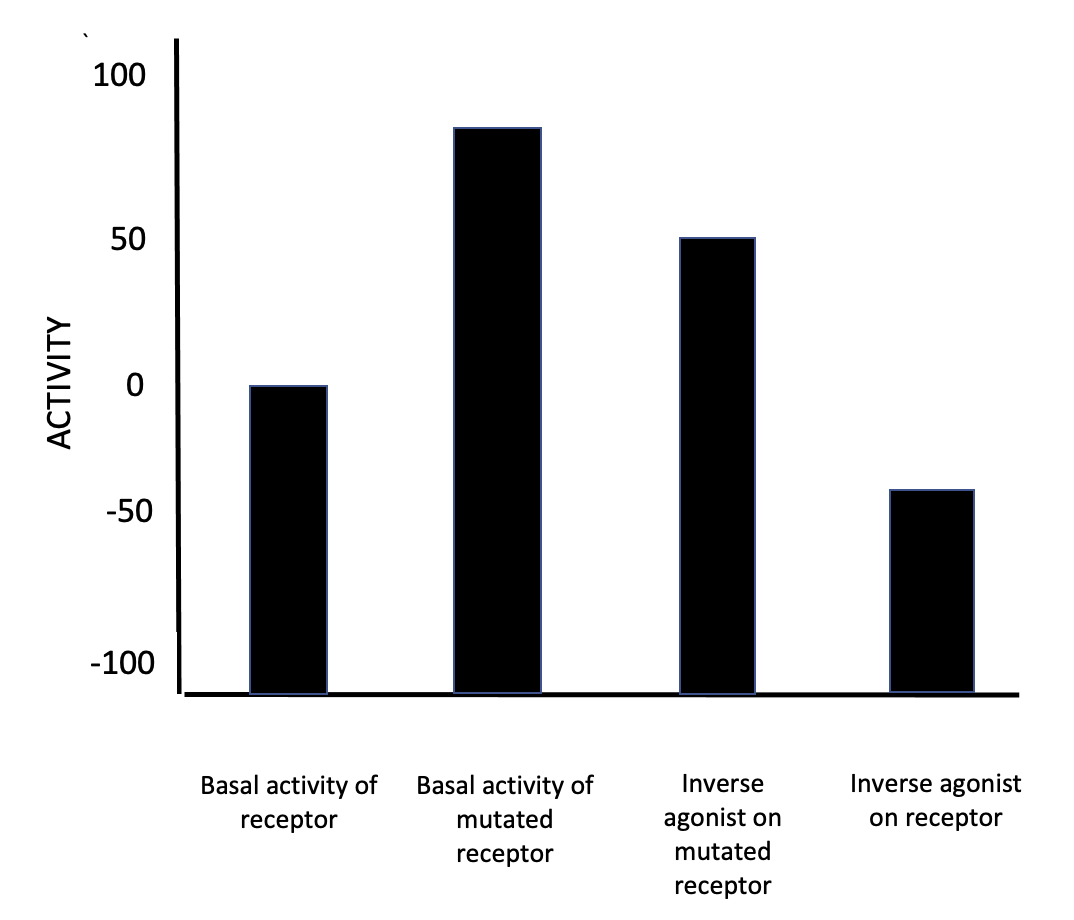|
Pimavanserin
Pimavanserin, sold under the brand name Nuplazid, is an atypical antipsychotic which is approved for the treatment of Parkinson's disease psychosis. It is taken by mouth. Side effects of pimavanserin include peripheral edema and confusion. Unlike other antipsychotics, pimavanserin is not a dopamine receptor antagonist, but rather is a selective antagonist or inverse agonist of the serotonin 5-HT2A receptor and to a lesser extent of the serotonin 5-HT2C receptor. Pimavanserin was first approved for medical use in 2016. It was approved as a generic medication in 2024. Medical uses Pimavanserin is used in the treatment of Parkinson's disease psychosis. Available forms Pimavanserin is available in the form of 10mg oral tablets and 34mg oral capsules. Side effects Side effects of pimavanserin include peripheral edema and confusion, among others. Pharmacology Pharmacodynamics Pimavanserin acts as a selective inverse agonist or antagonist of the serotonin 5-HT2A recepto ... [...More Info...] [...Related Items...] OR: [Wikipedia] [Google] [Baidu] |
Antipsychotic
Antipsychotics, previously known as neuroleptics and major tranquilizers, are a class of Psychiatric medication, psychotropic medication primarily used to manage psychosis (including delusions, hallucinations, paranoia or disordered thought), principally in schizophrenia but also in a range of other psychotic disorders. They are also the mainstay, together with mood stabilizers, in the treatment of bipolar disorder. Moreover, they are also used as adjuncts in the treatment of Treatment-resistant depression, treatment-resistant major depressive disorder. The use of antipsychotics may result in many unwanted side effects such as Extrapyramidal symptoms, involuntary movement disorders, gynecomastia, impotence, weight gain and metabolic syndrome. Long-term use can produce List of long term side effects of antipsychotics, adverse effects such as tardive dyskinesia, tardive dystonia, Akathisia, tardive akathisia, and brain tissue volume reduction. The long term use of antipsychotics ... [...More Info...] [...Related Items...] OR: [Wikipedia] [Google] [Baidu] |
5-HT2A Receptor
The 5-HT2A receptor is a subtype of the 5-HT2 receptor, 5-HT2 receptor that belongs to the serotonin receptor family and functions as a GPCR, G protein-coupled receptor (GPCR). It is a cell surface receptor that activates multiple intracellular signalling cascades. Like all 5-HT2 receptors, the 5-HT2A receptor is coupled to the Gq protein, Gq/G11 signaling pathway. It is the primary excitatory receptor subtype among the serotonin-responsive GPCRs. The 5-HT2A receptor was initially noted for its central role as the primary target of serotonergic psychedelic drugs such as LSD and psilocybin mushrooms. It later regained research prominence when found to mediate, at least in part, the effects of many antipsychotic drugs, particularly atypical antipsychotic, atypical antipsychotics. Downregulation of post-synaptic 5-HT2A receptors is an adaptive response triggered by chronic administration of selective serotonin reuptake inhibitors (SSRIs) and atypical antipsychotics. Elevated 5-HT2A ... [...More Info...] [...Related Items...] OR: [Wikipedia] [Google] [Baidu] |
Atypical Antipsychotic
The atypical antipsychotics (AAP), also known as second generation antipsychotics (SGAs) and serotonin–dopamine antagonists (SDAs), are a group of antipsychotic drugs (antipsychotic drugs in general are also known as tranquilizers and neuroleptics, although the latter is usually reserved for the '' typical antipsychotics'') largely introduced after the 1970s and used to treat psychiatric conditions. Some atypical antipsychotics have received regulatory approval (e.g. by the FDA of the US, the TGA of Australia, the MHRA of the UK) for schizophrenia, bipolar disorder, irritability in autism, and as an adjunct in major depressive disorder. Both generations of medication tend to block receptors in the brain's dopamine pathways. Atypicals are less likely than haloperidol—the most widely used typical antipsychotic—to cause extrapyramidal motor control disabilities in patients such as unsteady Parkinson's disease–type movements, body rigidity, and involuntary ... [...More Info...] [...Related Items...] OR: [Wikipedia] [Google] [Baidu] |
Tablet (pharmacy)
A tablet (also known as a pill) is a pharmaceutical oral dosage form (''oral solid dosage'', or OSD) or solid unit dosage form. Tablets may be defined as the solid unit dosage form of medication with suitable excipients. It comprises a mixture of active substances and excipients, usually in powder form, that are pressed or compacted into a solid dose. The main advantages of tablets are that they ensure a consistent dose of medicine that is easy to consume. Tablets are prepared either by moulding or by compression. The excipients can include diluents, binders or granulating agents, glidants (flow aids) and lubricants to ensure efficient tabletting; disintegrants to promote tablet break-up in the digestive tract; sweeteners or flavours to enhance taste; and pigments to make the tablets visually attractive or aid in visual identification of an unknown tablet. A polymer coating is often applied to make the tablet smoother and easier to swallow, to control the release rate ... [...More Info...] [...Related Items...] OR: [Wikipedia] [Google] [Baidu] |
Serotonin
Serotonin (), also known as 5-hydroxytryptamine (5-HT), is a monoamine neurotransmitter with a wide range of functions in both the central nervous system (CNS) and also peripheral tissues. It is involved in mood, cognition, reward, learning, memory, and physiological processes such as vomiting and vasoconstriction. In the CNS, serotonin regulates mood, appetite, and sleep. Most of the body's serotonin—about 90%—is synthesized in the gastrointestinal tract by enterochromaffin cells, where it regulates intestinal movements. It is also produced in smaller amounts in the brainstem's raphe nuclei, the skin's Merkel cells, pulmonary neuroendocrine cells, and taste receptor cells of the tongue. Once secreted, serotonin is taken up by platelets in the blood, which release it during clotting to promote vasoconstriction and platelet aggregation. Around 8% of the body's serotonin is stored in platelets, and 1–2% is found in the CNS. Serotonin acts as both a vasoconstrictor and vas ... [...More Info...] [...Related Items...] OR: [Wikipedia] [Google] [Baidu] |
5-HT2C Receptor
The 5-HT2C receptor is a subtype of the 5-HT2 receptor that binds the endogenous neurotransmitter serotonin (5-hydroxytryptamine, 5-HT). Like all 5-HT2 receptors, it is a G protein-coupled receptor (GPCR) that is coupled to Gq/G11 and mediates excitatory neurotransmission. ''HTR2C'' denotes the human gene encoding for the receptor, that in humans is located on the X chromosome. As males have one copy of the gene and females have one of the two copies of the gene repressed, polymorphisms at this receptor can affect the two sexes to differing extent. Structure At the cell surface the receptor exists as a homodimer. The crystal structure has been known since 2018. Distribution 5-HT2C receptors are located mainly in the choroid plexus, and in rats is also found in many other brain regions in high concentrations, including parts of the hippocampus, anterior olfactory nucleus, substantia nigra, several brainstem nuclei, amygdala, subthalamic nucleus and lateral habenula. ... [...More Info...] [...Related Items...] OR: [Wikipedia] [Google] [Baidu] |
Generic Medication
A generic drug is a pharmaceutical drug that contains the same chemical substance as a drug that was originally protected by chemical patents. Generic drugs are allowed for sale after the patents on the original drugs expire. Because the active chemical substance is the same, the medical profile of generics is equivalent in performance compared to their performance at the time when they were patented drugs. A generic drug has the same active pharmaceutical ingredient (API) as the original, but it may differ in some characteristics such as the manufacturing process, pharmaceutical formulation, formulation, excipients, color, taste, and packaging. Although they may not be associated with a particular company, generic drugs are usually subject to government regulations in the countries in which they are dispensed. They are labeled with the name of the manufacturer and a generic non-proprietary name such as the United States Adopted Name (USAN) or International nonproprietary name, Int ... [...More Info...] [...Related Items...] OR: [Wikipedia] [Google] [Baidu] |
Oral Administration
Oral administration is a route of administration whereby a substance is taken through the Human mouth, mouth, swallowed, and then processed via the digestive system. This is a common route of administration for many medications. Oral administration can be easier and less painful than other routes of administration, such as Injection (medicine), injection. However, the onset of action is relatively low, and the effectiveness is reduced if it is not absorbed properly in the digestive system, or if it is broken down by digestive enzymes before it can reach the bloodstream. Some medications may cause gastrointestinal side effects, such as nausea or vomiting, when taken orally. Oral administration can also only be applied to conscious patients, and patients able to swallow. Terminology ''Per os'' (; ''P.O.'') is an adverbial phrase meaning literally from Latin "through the mouth" or "by mouth". The expression is used in medicine to describe a treatment that is taken orally (but not ... [...More Info...] [...Related Items...] OR: [Wikipedia] [Google] [Baidu] |
Capsule (pharmacy)
In the manufacture of pharmaceuticals, encapsulation refers to a range of dosage forms—techniques used to enclose medicines—in a relatively stable shell known as a capsule, allowing them to, for example, be taken orally or be used as suppositories. The two main types of capsules are: * Hard-shelled capsules, which contain dry, powdered ingredients or miniature pellets made by ''e.g.'' processes of extrusion or spheronization. These are made in two-halves: a smaller-diameter "body" that is filled and then sealed using a larger-diameter "cap". * Soft-shelled capsules, primarily used for oils and for active ingredients that are dissolved or suspended in oil. Both of these classes of capsules are made from aqueous solutions of gelling agents, such as animal protein (mainly gelatin) or plant polysaccharides or their derivatives (such as carrageenans and modified forms of starch and cellulose). Other ingredients can be added to the gelling agent solution including plasticizers ... [...More Info...] [...Related Items...] OR: [Wikipedia] [Google] [Baidu] |
Inverse Agonist
In pharmacology, an inverse agonist is a drug that binds to the same receptor as an agonist but induces a pharmacological response opposite to that of the agonist. A neutral antagonist has no activity in the absence of an agonist or inverse agonist but can block the activity of either; they are in fact sometimes called ''blockers'' (examples include alpha blockers, beta blockers, and calcium channel blockers). Inverse agonists have opposite actions to those of agonists but the effects of both of these can be blocked by antagonists. A prerequisite for an inverse agonist response is that the receptor must have a constitutive (also known as intrinsic or basal) level of activity in the absence of any ligand. An agonist increases the activity of a receptor above its basal level, whereas an inverse agonist decreases the activity below the basal level. The efficacy of a full agonist is by definition 100%, a neutral antagonist has 0% efficacy, and an inverse agonist has < 0% (i.e., n ... [...More Info...] [...Related Items...] OR: [Wikipedia] [Google] [Baidu] |
Affinity (pharmacology)
In biochemistry and pharmacology, a ligand is a substance that forms a complex with a biomolecule to serve a biological purpose. The etymology stems from Latin ''ligare'', which means 'to bind'. In protein-ligand binding, the ligand is usually a molecule which produces a signal by binding to a site on a target protein. The binding typically results in a change of conformational isomerism (conformation) of the target protein. In DNA-ligand binding studies, the ligand can be a small molecule, ion, or protein which binds to the DNA double helix. The relationship between ligand and binding partner is a function of charge, hydrophobicity, and molecular structure. Binding occurs by intermolecular forces, such as ionic bonds, hydrogen bonds and Van der Waals forces. The association or docking is actually reversible through dissociation. Measurably irreversible covalent bonding between a ligand and target molecule is atypical in biological systems. In contrast to the definition o ... [...More Info...] [...Related Items...] OR: [Wikipedia] [Google] [Baidu] |







